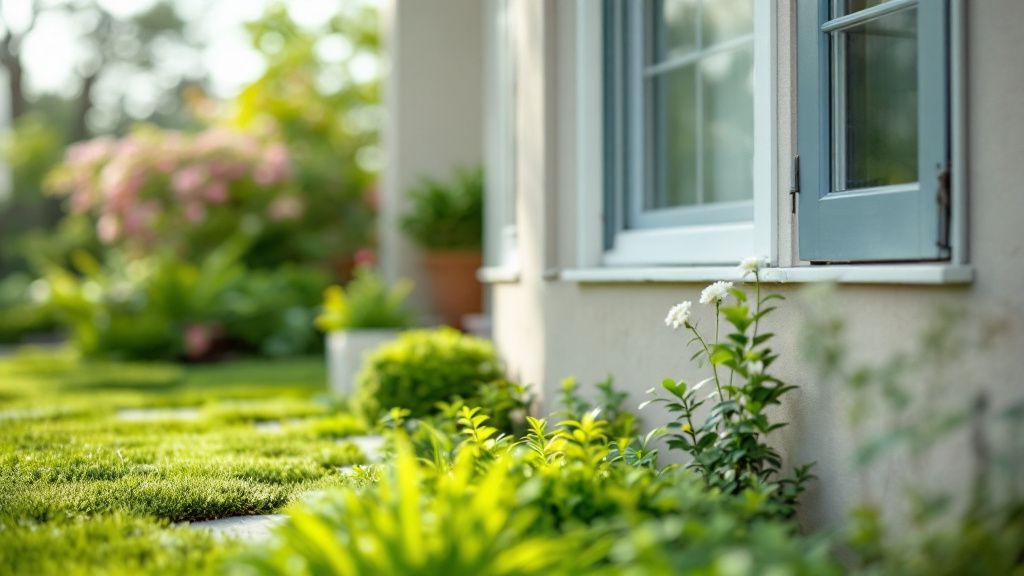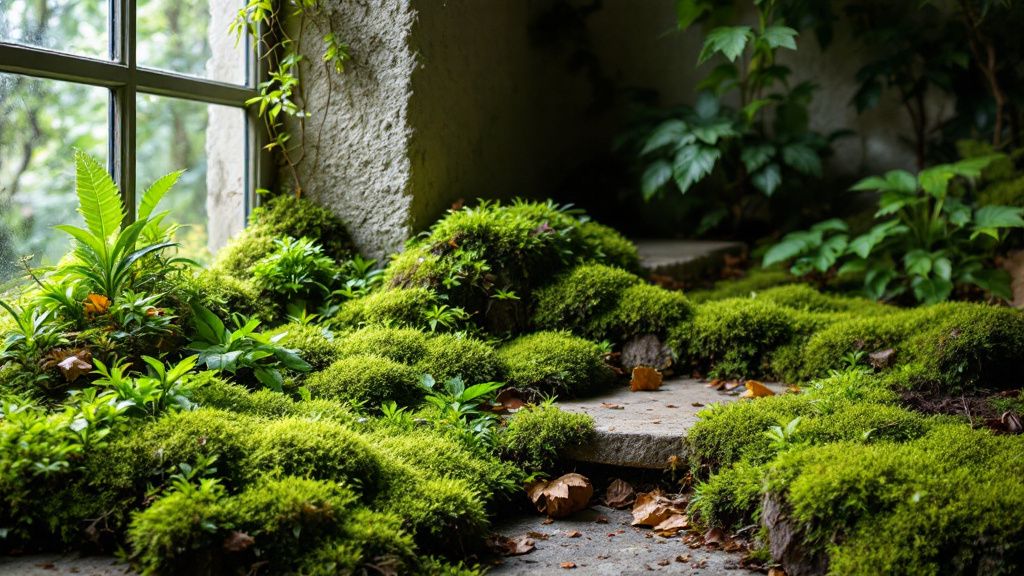Keeping moss out of your home begins with understanding that prevention and removal are crucial. You can start by regularly inspecting the exterior, especially shaded and damp areas where moss thrives. Ensure gutters and roofs are clear of debris to minimize moisture build-up, a common catalyst for moss growth. Investing in moss removal solutions like pressure washing can efficiently clean surfaces and dislodge stubborn growth. If you suspect moss in hard-to-reach areas, professional moss cleaning services offer expertise. Using treatments designed to prevent moss can also be a long-term safeguard. These effective strategies will help you maintain a clean, moss-free living environment.
Understanding Why Moss Grows Indoors
Moss has a fascinating ability to adapt, making it a persistent guest in many households. Tracing its evolution from ancient forests, moss has thrived in moist and dimly lit environments for millions of years. Today, its preference for dampness means your home, especially in humid climates or beneath leaky roofing, can provide an ideal habitat. Understanding the triggers for indoor moss growth, such as excessive moisture or inadequate ventilation, is key to anticipating and combating its presence.
To effectively manage moss in the house, it’s important to maintain environmental conditions that are less conducive to its growth. Regularly checking for and fixing leaks or poorly sealed windows that might allow excessive moisture can make a notable difference. If moss does begin to appear, utilizing moss cleaning solutions specifically designed for indoor use can address the problem efficiently. For long-term prevention, consider moss removal as part of a routine home maintenance plan, possibly even employing moss cleaning services for thorough inspections and cleanings. These steps will aid in controlling and reducing instances of moss indoors, making your living space healthier and more pleasant.
Preventative Measures to Stop Moss Growth
Maintaining a dry environment is essential to halt moss growth. Start by ensuring your home’s humidity levels remain low through proper ventilation, which can be achieved by using dehumidifiers or opening windows to allow air circulation. This simple adjustment cuts off the moisture moss needs to thrive, making it one of the best ways to get rid of moss before it even starts.
Regular maintenance routines can also play a crucial role. Clean roofs and gutters frequently to remove debris that can retain moisture. Comparing manual cleaning with pressure washing moss reveals that while both are effective, pressure washing offers a more thorough clean, swiftly eliminating potential breeding grounds. This method, however, should be employed with caution to avoid damage to surfaces.
For those seeking professional help, engaging moss cleaning services can be a prudent choice. These experts can provide tailored moss cleaning solutions, ensuring areas prone to moss in the house are addressed meticulously. Additionally, they can offer advice on how to prevent moss, sharing insights into long-term maintenance strategies that suit your specific environment and home structure.
How to Identify Moss in Your House
Spotting moss inside your home involves paying close attention to areas where it often thrives. Look in spaces with high humidity and low light, such as bathrooms, basements, or attics. Moss often appears as a soft, green or yellowish growth, clinging to surfaces and indicating excessive moisture. Familiarizing yourself with its texture and color is critical for early identification and effective moss removal.
Examining hidden or seldom-used areas is also crucial. What most people don’t see about indoor moss is the underlying moisture problems that contribute significantly to its spread, such as unseen leaks or inadequate insulation. Addressing these issues is key before implementing any moss cleaning solutions or preventive measures. This insight helps you mitigate future growth effectively.
Using simple tools like flashlights can assist in spotting hidden moss, especially in dimly lit areas. If you’re unsure, consult moss cleaning services that specialize in identification and offer insights on how to clean moss efficiently. Their expertise ensures that you not only address visible infestations but also discover and rectify the conditions promoting moss in the house. Additionally, these professionals can suggest preventive strategies tailored to the unique needs of your home.
Tools and Materials for Moss Removal
When tackling moss removal in the home, having the right tools on hand can make a significant difference in efficiency and effectiveness. Basic items such as stiff-bristle brushes and scrapers are vital for manually dislodging moss from surfaces. While these tools offer a hands-on approach, they are best suited for smaller areas and more accessible spots.
For larger or more stubborn patches, considering chemical moss cleaning solutions can be beneficial. These are typically sprayed onto affected areas, breaking down the moss at its roots for easy removal. Looking at moss removal through the lens of modern technology, pressure washers provide an efficient method, especially for external surfaces. This tool is powerful but should be used cautiously to avoid damage to more delicate home structures.
Protective gear is also an essential element, ensuring your safety during the process. Gloves, goggles, and masks protect you from irritants or chemicals used during cleaning. Many times, the expertise of moss cleaning services includes recommendations for safe and eco-friendly products, aligning with personal health and environmental considerations. This unique perspective underscores the balance between effective moss control and safeguarding your home and health.
DIY Methods to Remove Moss From Surfaces
You can tackle moss removal on your own using simple DIY methods that require readily available materials. Start with a mixture of vinegar and water, which can be an effective natural solution for treating moss. Spray the solution onto the moss-covered areas and let it sit for about 15 to 20 minutes. This helps kill the moss, making it easy to scrub off using a stiff-bristle brush.
Another practical approach involves using baking soda, known for its natural desiccation properties. Sprinkling baking soda over the affected areas and letting it sit overnight can significantly dry out the moss, allowing you to clean up with minimal effort the next day. According to recent studies, the high pH level of baking soda creates an inhospitable environment for moss, thereby aiding in its removal.
Pressure washing moss is also a favored method, especially for exterior surfaces. This method utilizes pressurized water to dislodge moss, offering a quick and effective cleaning solution. It’s crucial, however, to handle pressure washers with care to prevent damage to surfaces. Sometimes, consulting with moss cleaning services can be beneficial if you’re using pressure washing for the first time or dealing with larger infestations, ensuring comprehensive advice on how to clean moss properly.
Professional Help for Severe Moss Issues
When dealing with severe moss issues, professional intervention often provides the most efficient solution. Moss cleaning services have the experience and tools needed to address widespread or persistent growths quickly. They utilize specialized moss removal techniques and treatments tailored to different types of surfaces and levels of infestation, ensuring thorough and lasting results.
An often-overlooked advantage of professionals is their ability to prevent future moss problems. They not only remove existing moss but also apply preventive treatments to areas susceptible to regrowth. To make the most of professional services, try scheduling regular maintenance checks that can help identify and tackle potential issues before they escalate, thus safeguarding your home from persistent moss problems.
Many services offer eco-friendly moss cleaning solutions, reducing the impact on your home and the environment. Discussing options with professionals can also provide insights into additional home improvements, like better drainage systems or improved airflow, which help mitigate conditions that favor moss growth. Adopting this holistic approach ensures your home remains not only moss-free but also structurally sound and healthy.





